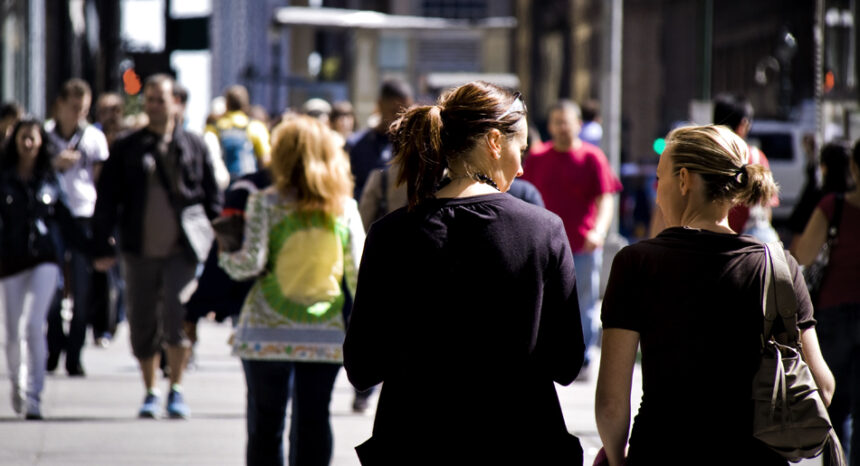A first-of-its kind study analyzing video footage of 3,552 pedestrians in two New York City neighborhoods finds people move farther around a pair of young Black men than a pair of young white men as they pass them on the sidewalk.
The paper, “Seeing Racial Avoidance on New York City Streets,” published in Nature Human Behaviour on Thursday, uses real-world observations to advance past research, done in controlled laboratory settings, on how participants physically react to people of different races.
“This idea of avoidance is not only something that happens all the time but I think people who are avoided know that this is happening and it does have an impact on the way they evaluate themselves vis-a-vis other people,” says co-author Bryce Dietrich, an associate professor of political science at Purdue University.
The experiments took place in Manhattan, with one location in Midtown East on Lexington Avenue and the other on the Upper East Side across from Central Park.
On two sunny, late spring and early summer days in 2017, the authors directed two white men in their 20s to stand talking for several 15-minute intervals near the middle of the sidewalk. They then used video from city-owned traffic cameras to observe how pedestrians moved past the men.
They did the same with two Black men at the same locations. The pairs wore similar clothing and were similar in height, weight and age. Most of the pedestrians were observed in Midtown, an area that typically has more foot traffic than the Upper East Side.
Some 93% of pedestrians captured on video were “phenotypically non-Black,” the authors write, meaning their skin pigmentation did not indicate they were African American. On average, “pedestrians will give a wider berth to phenotypically Black males than they do to phenotypically white non-Hispanic males,” write Dietrich and co-author Melissa Sands, an assistant professor of politics and data science at the London School of Economics and Political Science. Dietrich and Sands did not primarily focus on other characteristics of the pedestrians, such as apparent gender.
The authors note the sidewalk widths were different at each location, which may have influenced how people moved. The sidewalk at the Upper East Side location was about 2.5 feet shorter than the Midtown location. Across both sites, pedestrians avoided the Black pair by 3.1 to 4.4 inches more than the white pair, on average.
The additional pedestrian deviation when the Black pair was present amounted to 3.19% to 3.93% of the sidewalk width on the Upper East Side, and 3.24% to 3.47% in Midtown.
“One could challenge the importance of our findings by saying, ‘Well, it’s just a couple inches — this isn’t a big deal,’” Sands says. “But if you imagine this happening to you every time you go out in public, over and over again for your entire life, it really adds up.”
The locations were selected in part because the traffic cameras were angled to capture a large portion of the sidewalk. The locations also allowed the researchers to observe behavior in two types of neighborhoods — the more commercial Midtown and the more residential Upper East Side. Dietrich and Sands analyzed 225 minutes of video at each location.
Research assistants standing on the sidewalk documented whether they perceived pedestrians as being Black or not. Though most of the pedestrians were not evidently Black, the authors write that they find “no meaningful difference in the berth given by non-Black pedestrians as compared with all others.”
One limitation of the study, according to the authors, is that pedestrians did not represent a random sample of the U.S. population. They were observed in areas of the city typically populated by people who are “wealthier, better educated and more political left-leaning than the average American,” traits that “may or may not make subjects less prone to racial avoidance,” they write.
It is also difficult to generalize the results to other neighborhoods in New York City, or to other cities, towns or rural areas, all of which may vary greatly from the neighborhoods studied in terms of racial makeup and how their streets and sidewalks are laid out. Still, the study offers some of the most robust evidence of a link between racial perceptions and how people navigate their environments, “one of the many ways implicit biases are physically manifested in everyday behaviour,” the authors write.
Past research from Sands suggests seemingly subtle interactions can affect real-world policy preferences.
In a 2017 paper published in the Proceedings of the National Academy of Sciences, Sands had a professional actor portray a person with low income, “wearing extremely shabby clothes” in “affluent, predominantly white, pedestrian trafficked commercial areas around Boston,” she writes.
Sands then had the same actor switch into a business-casual outfit, portraying a person with apparently higher income.
After pedestrians passed the actor, they were approached by another actor playing a petitioner seeking signatures related to ballot measures on reducing the use of plastic bags and enacting a millionaire’s tax.
The appearance of the apparently poor or rich person did not affect responses to the plastic bag question.
But the appearance of the actor playing someone with low income did reduce support for a millionaire’s tax, which generally aims to redistribute wealth by increasing taxes on high-income earners.
“It’s like the opposite of an empathy effect,” Sands says.
The authors note their current research can be a template for future work analyzing racial avoidance and other pedestrian behavior using two-dimensional images, especially since high-quality cameras trained on public settings are common in cities and towns.
“Traffic camera networks — they’re all over the United States, they’re all over the world,” Dietrich says. “Average people don’t really even pay attention to the fact that they’re probably being filmed from afar on basically every city street. From that standpoint, that’s really useful, because it means we’re observing more natural reactions.”


Expert Commentary